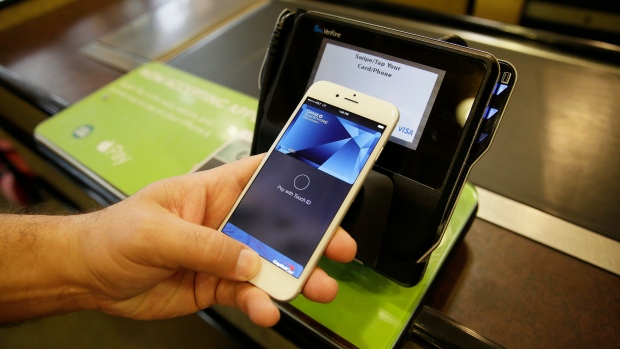May 10, 2016
Apple Pay expands in Canada, finally striking deal with big banks

Canada’s big banks have at last struck a deal with Apple Inc. (AAPL.O) that will give their customers access to the Cupertino-based company’s payment app for the iPhone, marking a potential shift in how consumers pay and striking a new relationship between financial institutions and the technology behemoth.
Royal Bank of Canada (RY.TO) and Canadian Imperial Bank of Commerce (CM.TO) will introduce Apple Pay to their customers on Tuesday, allowing them to store their credit cards and debit cards on their smartphones and make purchases valued at $100 or less. ATB Financial and Canadian Tire Financial Services are also offering the service, though initially only for credit cards.
Bank of Montreal (BMO.TO), Toronto-Dominion Bank (TD.TO) and Bank of Nova Scotia (BNS.TO) will follow in the coming months.
The deal between the banks and Apple, long after the payment service rolled out in the United States and the U.K., appears to end a long period of negotiations that at times suggested that the banks were balking at terms.
Moneris Solutions Corp., a payment processing company, said that the support for Apple Pay from the largest financial institutions will increase consumer adoption of the payment service significantly.
“Twenty-five per cent of transactions Moneris processes today are via contactless cards or devices,” said Rob Cameron, chief product and marketing officer at Moneris, in a statement. “With Apple Pay’s increased options and our leading market share in Canada, we are ready to educate, enable and support merchants across the country to accept Apple Pay today.”
MasterCard Canada said that 92 per cent of Canada’s top retailers are equipped to handle payments made without the physical presence of a credit card. The card company said that younger consumers, or so-called millennials, are especially motivated to use their smartphones as wallets.

An agreement with the big banks means that the payment app now will be widely available to Canadian consumers, given that about 38 per cent of Canadians use an iPhone. However, the payment app only works on newer versions of the smartphone, along with the Apple Watch and newer iPads.
Apple Pay first became available in Canada in October. But the initial roll-out was limited to non-bank issued American Express cards – a small slice of the Canadian market – because Apple and the big banks were not able to agree on terms.
According to the Financial Times, U.S. banks initially agreed to terms that gave Apple 15 cents for every $100 in transactions, which was considered overly favourable to Apple. Other financial institutions have since balked at surrendering a similar cut of fees, creating some hurdles to a widespread roll-out of Apple Pay globally.
In addition, banks have been worried that Apple could build deeper relationships with their customers, at a time when the banks are beset by potential competition from a hordes of nimble financial technology firms, or fintech.
Nonetheless, even notable early holdouts have been announcing agreements with Apple recently.
Barclays introduced Apple Pay to its customers in early April, making it the last among major UK lenders to offer the service.
In late April, Australia and New Zealand Banking Group Ltd. (ANZ), Australia’s fourth largest bank, announced in late April that it would offer the service ahead of its larger competitors.
“It would be pretty hypocritical of me to...do all this hoo-ha about digital banking and then not be at the forefront of change,” Shayne Elliott, chief executive officer of ANZ, told Reuters.
Apple Pay allows people to upload credit and debit cards to their iPhones. This gives customers the option of using their smartphones, rather than physical cards, to pay for items at merchant payment terminals equipped to handle remote payment technology.
The service is considered safe because unique tokens, or digital account numbers, are used instead of card numbers. If phones are lost or stolen, the payment app can be disabled.
Canadians with Android and BlackBerry devices have been able to use their smartphones to make purchases for some time, using rival payment technology.
However, the banks have not been marketing their digital wallets because the technology has been limited to consumers using the right phones at the right merchant terminals. As well, traditional credit card and debit card transactions in Canada – along with tap-and-go payments for small purchases – tend to be smooth, giving consumers little incentive to try out the new approach.
As a result, mobile payments are still a novelty in Canada. According to a recent survey by GfK Canada, these payments accounted for just 3 per cent of all payments in 2015 – and they included PayPal and the Starbucks app.
But many observers believe that mobile payments will gain traction as the technology behind it extends to all smartphone brands.








